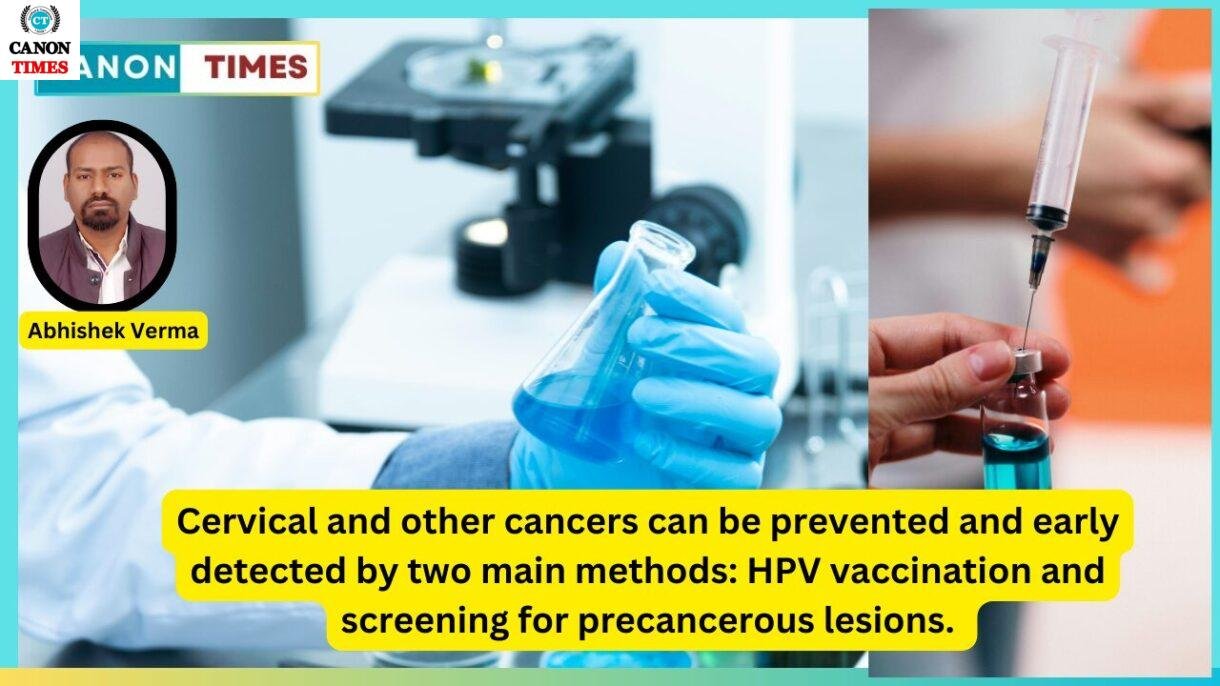Cervical and other cancers can be prevented and early detected by two main methods: HPV vaccination and screening for precancerous lesions.
January was designated as Cervical cancer Awareness Month. In addition, March 4 is designated as International HPV Awareness Day each year. The cervix, the bottom portion of the uterus, must be protected in order to preserve women’s health. Cervical malignancies can have a devastating impact on a woman’s health, but they can be prevented with the HPV vaccination.
Cervical cancer is the fourth most frequent malignancy in women globally, taking the lives of over 3,000 000 people annually, or one every two minutes. Ninety percent of women who pass away from cervical cancer reside in lower- and middle-income nations. After breast cancer, cervical cancer is the second most frequent cancer in India. With the magnitude of the nation’s population, 500 million or more women over the age of 15 are at danger of developing cervical cancer. Future projections indicate a significant increase in the number of cases and fatalities from cervical cancer if no action is done.
The total number of new cases of cervical cancer for all ages in India is predicted to reach 1,91,347 in 2040 at the present pace of population growth, a 54% increase over the number of new cases recorded in 2020.

Preventative techniques
German scientist Harald zur Hausen first showed in 1983 that certain papillomaviruses, often known as wart viruses, are the culprits behind human cervical cancer. Two key methods for early diagnosis and prevention have been developed as a result of understanding HPV epidemiology and its connection to cancer: HPV vaccine and precancerous lesion screening. While it is possible to completely eradicate cervical cancer, the sad truth is that many underprivileged communities still do not have access to effective intervention initiatives to end cervical cancer as a public health issue. The World Health Organization’s 2030 plan calls for the implementation of a 90-70-90 triple pillar intervention, with an extra emphasis on equitable and high-quality health care services. The intervention targets are as follows: 70% of women must be screened with a high-performance screening test by the age of 35 and again by the age of 45; 90% of girls must receive the full HPV vaccine by the age of 15; and 90% of women who have cervical pre-cancer and cancer lesions must receive treatment and care. The commitment of India’s G20 presidency to encouraging equitable access to vaccinations, particularly for lower- and middle-income countries, was underlined in a recent study titled “Accelerating global health pathways: to health equity for the G20.” 2008 saw the introduction of the HPV vaccination in India. It was suggested that the Universal Immunisation Programme include it in 2023 following effective studies conducted at the national level and state-level rollouts. The Health Ministry first announced this in early 2023, and the Finance Minister most recently brought it up in her Interim Budget address. Now, a nationwide rollout of the vaccine is anticipated. Studies reveal that not every girl in India has universal access to the HPV vaccination. At a significant out-of-pocket expense, it is currently offered on the private market.
A lot of doctors don’t realise how common and dangerous HPV infection and cervical cancer are.
Also, doctors undervalue the efficacy and safety of HPV vaccinations. Recommending the HPV vaccine to parents of teenagers who meet the eligibility requirements is hesitant due to a lack of confidence in the safety and effectiveness of the vaccine.
Since that intimate skin-to-skin contact is the primary method of transmission for HPV infections, doctors could be reluctant to suggest this cancer prevention vaccine. Additionally, they might think it would take a lot of time to respond to queries from parents concerning myths and false information surrounding the HPV vaccine.
Data and recommended procedures
Information and recommended procedures
with a combined membership of over 80,000 physicians, the Federation of Obstetric and Gynaecological Societies of India (FOGSI) and the Indian Academy of Paediatrics (IAP) have united to support the much-anticipated national roll-out of the HPV vaccine. They aim to remind member obstetricians-gynecologists and paediatricians about the facts of HPV vaccination and share best practices for effectively communicating with parents about this cancer-preventing vaccine. There are six HPV malignancies that this safe and effective vaccination can help prevent. The vulvar, anal, vaginal, throat, and cervical are the five that affect women.
One of the requirements for fulfilling the IAP vaccination schedule is recommending the HPV vaccine to all teenagers beginning at age 9. Following an analysis of the available data, the FOGSI Good Clinical Practice Guidelines have reaffirmed its suggestions for routine screening for women over 30 and HPV vaccination for the key age range of 9 to 14 years old.
Aiming to safeguard every child from cervical cancer by HPV vaccination and every woman from cervical cancer through routine cervical screening, the FOGSI and IAP are leading national medical societies with a history of advancing community health and well-being.
By mid-2024, they hope to have at least 20,000 HPV physician champions in their networks. These participating doctors will educate their peers and the general public about the value of HPV vaccination.
As the most reputable authorities in the community, doctors are the go-to person for any information pertaining to health. For India to become cancer-free, their leadership is required.
Abhishek Verma
Author: This news is edited by: Abhishek Verma, (Editor, CANON TIMES)
Authentic news.






